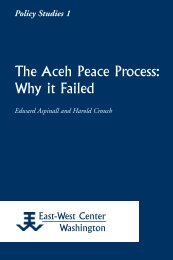Constructing Papuan Nationalism: History, Ethnicity ... - ScholarSpace
Constructing Papuan Nationalism: History, Ethnicity ... - ScholarSpace
Constructing Papuan Nationalism: History, Ethnicity ... - ScholarSpace
- No tags were found...
Create successful ePaper yourself
Turn your PDF publications into a flip-book with our unique Google optimized e-Paper software.
50 Richard Chauvelofficials, police, and teachers. Although still relatively small in number,this <strong>Papuan</strong> educated elite had played a disproportionate role in the formulationand articulation of <strong>Papuan</strong> nationalism.During the Dutch period, the rivalry between <strong>Papuan</strong>s andIndonesians had involved but small numbers of Indonesians and <strong>Papuan</strong>s.The massive demographic transformation Papua has experienced since1963 has changed the dynamics of <strong>Papuan</strong>-Indonesian relations for all of <strong>Papuan</strong> society andhas given <strong>Papuan</strong> nationalism a sharp ethnicexpression. In 1960, the “Asian” population, consistingmainly of Javanese, Chinese, and easternIndonesians, numbered just 18,600 (2.5%) outof an estimated population of 736,700. 82 Fortyyears later, the 2000 Census indicated that thenumber of non-<strong>Papuan</strong>s residing in the provincewas 772,684, or 35% of the population. In some areas, the percentageswere even higher, being as much as 68% in urban areas of Jayapura,Sorong, and Fakfak. 83 The largest groups of settlers were Javanese,Buginese, Makasarese, Ambonese, Menadonese, and Bataks. 84 This influxof Indonesians has given <strong>Papuan</strong>s a sense of having lost control of theirown homeland and caused them to feel they have been made marginal toPapua’s political and economic life.Migration to Papua has come in two forms, which have involved twodifferent patterns of settlement (McGibbon 2004b). The first type of settleris the transmigrants, coming mostly from Java, that the governmenthas settled in rural areas. Overall, the transmigrants are still a small minorityof the province’s rural population, but in the transmigration sitesaround Jayapura, Merauke, Paniai, Fakfak, and Sorong they have overwhelmedthe local <strong>Papuan</strong> population. For example, in Arso, locatedbetween Jayapura and the border with PNG, the <strong>Papuan</strong> population of3,000 has been dwarfed by 18,000 transmigrants. Not only are they outnumbered,but the <strong>Papuan</strong>s in Arso have felt isolated, marginalized, andculturally dominated, as they can not compete economically and politicallywith the more numerous and better connected transmigrants.Moreover, the communities have tended to live and work separately, withlimited interaction and cooperation. 85The second kind of immigration is the influx of voluntary migrantswho were attracted by the economic opportunities in the urban areas ofThis influx ofIndonesians has given<strong>Papuan</strong>s a sense of havinglost control of theirown homeland
















